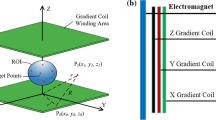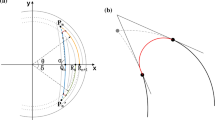Abstract
This study introduces a method for designing the Z-gradient coil in a low-field (0.05 T) magnetic resonance imaging (MRI) system, taking into consideration the adverse effects of Z-gradient coil-induced eddy currents (gradient eddy currents). The gradient coil with a better anti-eddy performance means that it produces smaller eddy currents in the surrounding structures and thus has a smaller impact on imaging results. The electromagnetic complexity of the device makes it challenging to evaluate the impact of Z-gradient coil-induced eddy currents. To address this issue, a simplified two-dimensional model based on the finite-element method (FEM) is proposed. A multi-objective optimization method is approximately solved to get the Pareto front, considering nonlinearity, gradient efficiency, and inductance. The simulated field response and eddy losses serve as the final evaluation factors to ensure that the good anti-eddy performance. The fabricated optimal Z-gradient coil is tested and compared with a coil designed from the conventional method. Experimental eddy current response and T2-weighted image comparison show that the optimal coil has better anti-eddy performance than the conventional coil.






















Similar content being viewed by others
Availability of Data and Materials
Data supporting this study are included within this article. For more data, please contact kong@em.ist.hokudai.ac.jp.
References
M.H. Mazurek, B.A. Cahn, M.M. Yuen et al., Portable, bedside, low-field magnetic resonance imaging for evaluation of intracerebral hemorrhage. Nat. Commun. 12(1), 5119 (2021). https://doi.org/10.1038/s41467-021-25441-6
Y. He et al., Use of 2.1 MHz MRI scanner for brain imaging and its preliminary results in stroke. J. Magn. Reson. 319, 106829 (2020). https://doi.org/10.1016/j.jmr.2020.106829
L. Yang, W. He, Y. He, J. Wu, S. Shen, Z. Xu, Active EMI suppression system for a 50 mT unshielded portable MRI scanner. IEEE. Trans. Biomed. Eng. (2022). https://doi.org/10.1109/TBME.2022.3170450
M. Sarracenia et al., Low-cost high-performance MRI. Sci. Rep. 15(5), 15177 (2015). https://doi.org/10.1038/srep15177
C.Z. Cooley et al., A portable scanner for magnetic resonance imaging of the brain. Nat. Biomed. Eng. 5(3), 229–239 (2021). https://doi.org/10.1038/s41551-020-00641-5
W.M. Spees, N. Buhl, S. Peng, J. Ackerman, J.J. Neil, J.R. Garbow, Quantification, and compensation of eddy-current-induced magnetic-field gradients. J. Magn. Reson. 212(1), 116–123 (2011). https://doi.org/10.1016/j.jmr.2011.06.016
J.O. Nieminen et al., Avoiding eddy-current problems in ultra-low-field MRI with self-shielded polarizing coils. J. Magn. Reson. 212(1), 154–160 (2011). https://doi.org/10.1016/j.jmr.2011.06.022
X. Kong, Z. Xu, S. Shen, J. Wu, Y. He, L. Xuan, H. Igarashi, Gradient coil design method specifically for permanent-magnet-type low field portable MRI brain scanner. IEEE Trans. Instrum. Meas. 72, 1–12 (2022). https://doi.org/10.1109/TIM.2022.3225042
V.J. Schmithorst, B.J. Dardzinski, Automatic gradient pre-emphasis adjustment: a 15-minute journey to improved diffusion-weighted echo-planar imaging. Magn. Reson. Med. 47(1), 208–212 (2001). https://doi.org/10.1002/mrm.10022
M. Akram et al., Coupled circuit numerical analysis of eddy currents in an open MRI system. J. Magn. Reson. 245, 1–11 (2014). https://doi.org/10.1016/j.jmr.2014.05.001
L. Xia et al., Finite element analysis of gradient z-coil induced eddy currents in a permanent MRI magnet. J. Magn. Reson. 208(1), 148–155 (2011). https://doi.org/10.1016/j.jmr.2010.10.017
R. Turner, Gradient coil design: a review of methods. Magn Reson Imaging 11(7), 903–920 (1993). https://doi.org/10.1016/0730-725x(93)90209-v
S. Shen, N. Koonjoo, X. Kong et al., Gradient coil design and optimization for an ultra-low-field MRI system. Appl. Magn. Reson. 53, 895–914 (2022). https://doi.org/10.1007/s00723-022-01470-2
L. Xuan, X. Kong, J. Wu et al., A smoothly-connected crescent transverse gradient coil design for 50mT MRI system. Appl. Magn. Reson. 52, 649–660 (2021). https://doi.org/10.1007/s00723-021-01330-5
Y.P. Du, D.L. Parker, Optimal design of gradient coils in MR imaging: Optimizing coil performance versus minimizing cost functions. Magn. Reson. Med. 40(3), 500–503 (2005). https://doi.org/10.1002/mrm.1910400323
C. Cobos Sanchez, M. Pantoja, M. Poole, A. Bretones, Gradient-coil design: a multi-objective problem. IEEE Trans. Magn. 48(6), 1967–1975 (2011). https://doi.org/10.1109/TMAG.2011.2179943
D. Tomasi, Stream function optimization for gradient coil design. Magn. Reson. Med. 45(3), 505–512 (2001). https://doi.org/10.1002/1522-2594(200103)45:3%3c505:AID-MRM1066%3e3.0.CO;2-H
R. Turner, A target field approach to optimal coil design. J. Phys. D. 19(8), L147–L151 (1986). https://doi.org/10.1088/0022-3727/19/8/001
M.A. Brideson, L.K. Forbes, S. Crozier, Determining complicated winding patterns for shim coils using stream functions and the target-field method. Concepts Magn Reson Part A 14(1), 9–18 (2002). https://doi.org/10.1002/cmr.10000
H.S. Lopez, Equivalent magnetization current method applied to the design of gradient coils for magnetic resonance imaging. IEEE Trans. Magn. 45(2), 767–775 (2009). https://doi.org/10.1109/TMAG.2008.2010053
M. Barton, Loss calculation in laminated steel utilizing anisotropic magnetic permeability. IEEE Trans. Power Syst PAS-99(3), 1280–1287 (1980). https://doi.org/10.1109/TPAS.1980.319760
H. Igarashi, K. Watanabe, A. Kost, A reduced model for finite element analysis of steel laminations. IEEE Trans. Magn. 42(4), 739–742 (2006). https://doi.org/10.1109/TMAG.2006.872470
W.A. Roshen, Effect of finite thickness of magnetic substrate on planar inductors. IEEE Trans. Magn. 26(1), 270–275 (1990). https://doi.org/10.1109/20.50553
J. Simpson, J. Lane, C. Immer, R. Youngquist, “Simple analytic expressions for the magnetic field of a circular current loop”. NASA Technical Reports Server (NTRS) Collection (2003), https://ntrs.nasa.gov/citations/20010038494.
Y. Cheng, Y. Shu, A new analytical calculation of the mutual inductance of the coaxial spiral rectangular coils. IEEE Trans. Magn. 50(4), 1–6 (2013). https://doi.org/10.1109/TMAG.2013.2290972
Funding
This work was supported by the Japan Science and Technology Agency (JST), under Grant JPMJSP2119, National Natural Science Foundation of China, under Grant 52077023, and Shenzhen Science and Technology Innovation Commission, under Grant CJGJZD20200617102402006.
Author information
Authors and Affiliations
Contributions
XK wrote the main manuscript text; ZX and IH provided the conception and critical revision of this work; SS, JW, and YH collected data from experiments.
Corresponding authors
Ethics declarations
Conflict of interest
I declare that the authors have no competing interests as defined by Springer, or other interests that might be perceived to influence the results and/or discussion reported in this paper.
Ethical Approval
Ethical approval is not applicable for this article.
Additional information
Publisher's Note
Springer Nature remains neutral with regard to jurisdictional claims in published maps and institutional affiliations.
Rights and permissions
Springer Nature or its licensor (e.g. a society or other partner) holds exclusive rights to this article under a publishing agreement with the author(s) or other rightsholder(s); author self-archiving of the accepted manuscript version of this article is solely governed by the terms of such publishing agreement and applicable law.
About this article
Cite this article
Kong, X., Xu, Z., Shen, S. et al. Z-Gradient Coil Design with Improved Anti-eddy Performance for MRI System with Opposed Permanent Magnets. Appl Magn Reson 54, 869–890 (2023). https://doi.org/10.1007/s00723-023-01577-0
Received:
Accepted:
Published:
Issue Date:
DOI: https://doi.org/10.1007/s00723-023-01577-0




